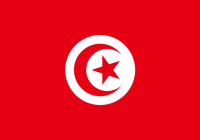


Tunisia
Tunisia is a North African country whose culture dates to antiquity. In the capital, Tunis, the palatial Bardo Museum presents archaeological exhibits from Roman mosaics to Islamic art. Its population is 10 million people and GDP per capita of USD 4,316
Tunisia, an upper-middle income country, has undergone a political transition following “”Arab Spring”” civil protests in 2011. HIV prevalence among the general population appears to be stable and has remained low in the last 10 years, but key populations account for a larger number of prevalent cases. These include mainly men who have sex with men, people who inject drugs, sex workers and migrants. The country’s estimated number of new infections in the adult population per year is increasing. As in other countries of the Middle East and North African region, AIDS-related deaths and new infections are on the rise in Tunisia. While still under control, TB prevalence, incidence and mortality rates have increased in recent years.
AHO PRIORITIES FOR HEALTH DELIVERY PLAN IN TUNISIA
- Health status of women and children.
- Access to quality health care, particularly for the poor with an emphasis on prevention and promotion through strengthened primary care .
- Procurement and delivery of drugs and medical supplies.
- Efficiency of health services/Facility rationalization strategies/Management capacity.
- Work terms and conditions for health personnel.
PROGRAMMES & PROJECTS
1. DISEASE PREVENTION AND CONTROL
PURPOSE
To strengthen the capacity of national authorities to control communicable and noncommunicable diseases
EXPECTED RESULTS
- Program for the Prevention of Communicable Diseases strengthened.
- Program for the Control of Noncommunicable Diseases strengthened.
- Implementation of Integrated Management of Childhood Illnesses strengthened in all regions.
- Capacity to monitor health situation strengthened by improving the quality of data and timeliness of reporting.
- Project on disease prevention and control managed effectively.
2. MANAGERIAL PROCESS FOR NATIONAL HEALTH DEVELOPMENT
PURPOSE
To administer international technical cooperation for health effectively
EXPECTED RESULTS
- Delivery of technical cooperation enhanced through the efficient and effective management of the AHO office.
- Technical cooperation program delivered through the effective and efficient management of information systems and infrastructure.
- Opportunities provided for staff development in response to increased needs for expertise in their respective areas of work.
- Preventive maintenance conducted on office buildings, equipment, and vehicles.
- Donor coordination meetings on health convened at least twice a year.
- Development of the virtual health library supported.
3. HEALTH SYSTEMS AND SERVICES DEVELOPMENT
PURPOSE
To strengthen the capacity of AHO to develop and implement health systems and services
EXPECTED RESULTS
- Strategies implemented to strengthen the steering role of AHO.
- Quality assurance programs developed for health services.
- Programs developed to improve oral and eye health and the health.
- Increased capacity of AHO to monitor and regulate the pharmaceutical system.
- Project effectively managed.
- Quality projects.
4. HEALTH OF SPECIAL GROUPS
PURPOSE
To enhance the capacity of public, nongovernmental, and community-based organizations to apply health promotion strategies
EXPECTED RESULTS
- Capacity to establish and expand network of health promoting schools strengthened.
- Capacity for delivering maternal and perinatal health care services strengthened.
- Capacity for addressing health needs of vulnerable groups strengthened at the national and regional levels.
- Capacity for planning, implementing, and evaluating the healthy municipalities and communities strategy strengthened.
- The development of mental health services strengthened at the national and regional levels.
- Capacity for planning and implementing social communication strategies enhanced to promote healthy lifestyles
- Project effectively managed.
5. HEALTH AND ENVIRONMENT
PURPOSE
To increase national capabilities to address environmental health issues (promoting healthy spaces, pollution control, and environmental protection).
EXPECTED RESULTS
- The EH System improved through institutional strengthening.
- Conceptual and analytic capabilities strengthened in environmental risk management and assessment.
- Public awareness and community participation increased on environmental health issues.
- Leadership promoted on environmental health.
- Project coordinated.
RESOURCES (USD)
AHO TUNISIA 2020 (USD million)* based on 2017 population of 11.53 million, World Bank
| SO | BUDGET ITEM | AMOUNT* |
| 1 | Combating communicable diseases |
192 |
| 2 | Tackling non communicable diseases |
200 |
| 3 | Addressing determinants of health & risk factors |
190 |
| 4 | Modernising health system and health service |
195 |
| 5 | Improving preparedness, surveillance and response |
198 |
| 6 | Developing good governance & corporate services |
178 |
| Total |
1,153 |
AHO estimates that it needs to spend at least USD100 per capita on health to meet the basic health needs of the people in Africa. This is too far below developed countries e.g. in England it is US$1,300 per capita (2017)

